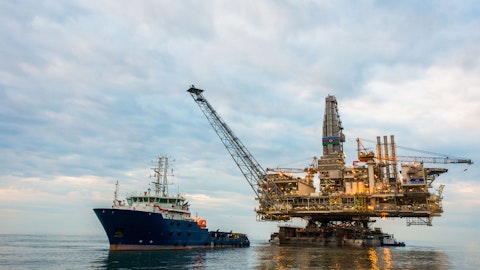So Ryan’s team is working that into the budget, but all that works in our favor as well too. So we’ll see how that ends up playing out. But very happy with both the ops team on what they’ve been doing to-date and then as well the procurement division on what they’ve been working with our service providers on, so.
Jeremy McCrea: Okay. And maybe just a quick follow-up there too. Is there any new concepts that you haven’t talked about here today? Like I said, we talked about trying to plug and perf versus the NCS. Is there any other new concepts that you’re going to test over the rest of the year that you’ll talk about coming Q2, Q3, and say, hey, actually, that actually kind of worked here.
Craig Bryksa: Go ahead.
Ryan Gritzfeldt: Yes, I don’t think so, Jeremy. I think what we’re doing right now keeps us busy with new things. Craig mentioned we just drilled the longest onshore well in Canada in the Duvernay. We’ve had questions. Well, what did you do differently? And honestly, not a lot different. It’s just taking the learnings. We’ve been in the play now for what three years? It’s taking the learnings and applying them, and that’s why I say some of these things take time. And — but with all the things we do have going on right now, it’s exciting to see where we can bring our cost to, like Craig mentioned with supply chain management, with our operations team continuing to push the limits. But in terms of, like, new things like plug and perf and Gold Creek East that we’re trying. There really isn’t anything new that I can speak of.
Craig Bryksa: And Jeremy, I’d add to that in our teams, as you get in here, they learn from each other, and the Duvernay team learns from the Montney team, and away they go. And we apply different things as we go. So it’s a consistent evolution and always being innovative around that. So you’re always looking at different muds and bid systems and how that works. So ideally that drives your cost structure. The other thing is, we’re typically a little bit more conservative on our well spacing, as you’re well aware. We like to be. We’d rather be a little bit wider and creep our way in, as opposed to being too tight and have to creep our way out and revise inventory to the negative. So one thing you will see us do this year, Ryan said it earlier on the call is with the success we’ve been having in Gold Creek West these like that last pad is called 1,800 BOE per day on average per well at 85% oil or liquids.
Look for us to tighten in that spacing on an offsetting pad to the pad’s going to go directly to the West. We’re going to tighten in that spacing. We’re going to go from five wells to seven wells per DSU. Ideally, we get some very good strong results like we’ve been seeing, and then that opens up inventory in that entire airway or area. So it’s going to be a lot more of that. And then obviously, when you think of the geos and how our landing zones and how they’re steering the wells, they learn as we go. Let’s see, optimal landing position. How do you want to stagger your zones between the different areas? So it’s going to be more of that, just getting smarter and then look for us over the years to get even better. And like Ryan mentioned, that Duvernay well, we’ve been running in the Duvernay now for three years, but over three years, so that well is 19 or basically 9,017 meters, that horizontal leg was 5,400 meters long.
And Jeremy, we did that in one bit run. So not only is it the longest well in Canada, it’s also drilled half a day faster than the peer who had that title in front of us. So the team, they did an incredible job on that. But — so we’ll see how it plays out with us in the Montney.
Operator: Thank you. Your next question comes from Travis Wood with National Bank Financial. Please go ahead.
Travis Wood: Yes, thanks, and good morning. The question’s probably for Ken. I just wanted to take it back to what Dennis was getting at around debt; I guess a couple questions to get here. First, any more assets to be sold, smaller, non-core stuff, the scraps that are left in the portfolio? And then how should we — is debt to cash the right way to think about where leverage sits? Or as you think about accelerating debt repayment? Could we start to think this on a debt to cap base or what’s the right way to think about that? And how low should the absolute debt number get to? So a lot of questions in there, but kind of just driving at one. And then any way to accelerate some of the repayment of the senior notes and the bonds that are coming due over the next couple of years.
Craig Bryksa: Hey Travis, thanks for the question. I’ll maybe grab the first one as far as A&D, and then I can pass it to Ken on the debt and the debt structure and how we’re looking at optimizing the balance sheet. As far as A&D, Travis, you’ve watched Crescent Point over the last six years, but in the last maybe three years in particular on the movement within the portfolio, and I did mention to you that we’re going to take a good long pause as far as the acquisitions. We’re happy with how things have come together here, so don’t look for us this year to do anything on the acquisitions front. I would also tell you too as far as the upstream dispositions, when you look at now with us having moved off — what we just moved off recently here both in Alberta and Saskatchewan.
We’re pretty — we’re excited with how the portfolio fits and stands today. So I wouldn’t look for any near-term dispositions, further dispositions, upstream dispositions either. So again, happy with that as far as that movement on the portfolio. And then we’ll look to execute here over the next call to 12-ish months, and then I’ll maybe pass to Ken as far as the debt structure and balance sheet optimization.





